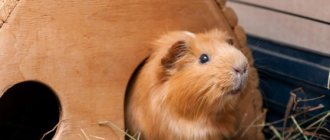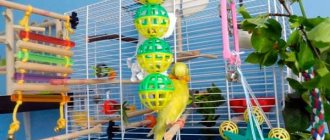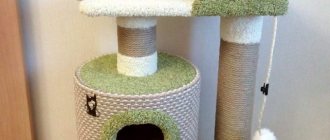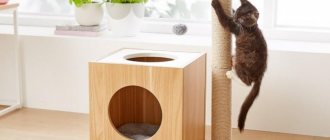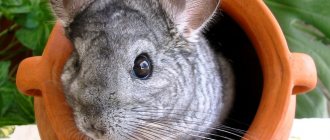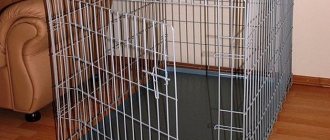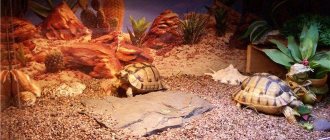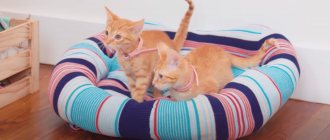House for a chinchilla: types and methods of production
It's no secret that before purchasing a pet, you should first take care of where it will live.
No, of course, he will live with you, in your house. But everyone should have their own little corner, no matter whether it’s a dog or a cat, or maybe even a chinchilla. It is especially important to choose a house for small and active animals. The chinchilla is one of these animals.
Now in any pet store you can find a variety of houses, cages or display cases for rodents that meet all standards or dimensions: from small and small to medium, and even large.
Below we will look at which house will be better for chinchillas, how to choose the material and filling.
Prevention and care of the house
To protect your pet, the installation of the house is carried out with an eye to prevention:
- the dwelling must be tightly attached to the wall or mesh;
- Careful adjustment of the surfaces is important (no gaps where a curious animal would immediately stick its paw);
- various chips and cracks are excluded;
- It is extremely undesirable to use traumatic fasteners - iron screws or self-tapping screws.
Home maintenance is quite simple.
Video: how to clean a chinchilla's window display
It is enough to promptly remove from the house any remaining food that has found its way there and the old layer of sawdust. To do this, the structure is simply raised.
Check out such popular rodents as: guinea pig, chipmunk, squirrel, jerboa, rats, prairie dogs, dormouse, ground hare, hamsters (Djungarian, wild and Syrian), and capybara.
It is advisable to wipe the walls with the same frequency (once a week) with a slightly damp cloth.
Major disinfection is carried out every 2-3 months. All surfaces of the house are wiped with swabs soaked in an alcohol solution of salicylic acid (concentration 1 or 2%). But there is one caveat - before use it is mixed with boiled water in equal parts.
What is a house for?
Chinchillas are animals that love secluded places. There were cases when the little animal did not have its own secluded corner, and it fell into depression and then fell ill.
A house for any creature is a place where you can rest, sleep and relax, there will not be any further disturbances or disturbances.
You also need housing if you subsequently decide to breed animals. For a female chinchilla, the house will be the very place where she will be comfortable raising offspring and caring for them, without trying to find a secluded corner.
From the above it is clear that the animal loves privacy, so the house itself - no matter whether it is equipped in a cage or in a display case - should be placed in the darkest and most unlit corner.
Often the optimal place for the home is the bottom of the cage, so as not to worry about your pet once again. But if, in a design impulse, you decide to install an overnight shelter for an animal on a shelf, you should securely attach the walls of the structure to the rods and shelf.
This is because a chinchilla can steal a house or move it to the place it wants, and if the house is on a shelf, then the pet can fall along with the house and get injured.
A common material for making animal houses is wood. Budget-friendly and affordable material from which you can even build a house yourself.
The next most popular is plastic, even ceramics are less common. You can find wicker houses or those made from twine on the Internet. But they are not very practical, since the rodent will simply chew its house.
Wood is the best option, it is common and easy to work with. You can give it a variety of shapes, relief and appearance.
If we consider a small-sized cage, then the most common shapes are rectangular, round, oval, and less often triangular houses. You can, of course, find more intricate houses - castles or Indian wigwams. Here everything depends, if not on imagination, then on the price point.
In order not to make a mistake with the shape of the house, it is worth remembering the following points.
- The size of the house is selected based on the size of the rodent, its height, and density. The passage should be free, not impede movement, and the interior area of the house itself should also be free.
- No small or narrow holes. A chinchilla’s paw can get stuck in such holes, which can lead to injury, and if the “window” seems large enough to the chinchilla, it will definitely try to climb out through it and get stuck.
- The more doors or windows, the better. Air circulation is very important for your pet.
- If the house will stand at the bottom of a cage or display case, then you should choose a house without a bottom, as cleaning will be easier and more convenient.
- Sharp tips on locks or domes will impress your guests, but it can be dangerous for the baby animal. If the house is at the bottom of the cage, there is a high chance that the pet from the upper shelves may fall off and, falling on the tip of the dome, be injured.
- You should not skimp on the number of houses if you place several chinchillas in one cage. It is vital for them to have their own home, and if there is only one house, then there will be a fight between the pets for place of residence.
Wooden houses
Any material has its certain advantages, but also has disadvantages. Before choosing, you should always consider the material from different angles.
The tree does not have any restrictions; the houses can be either one-story or two- or three-story. It all depends on the wishes of the owner. The house can be equipped with a fence or a small veranda; a ladder or even a running wheel can be attached to the side. Due to this compactness, space is saved, which plays an important role if the cell itself is small in size.
The positive aspects of wood as a material for a house.
- The most common advantage is accessibility. There are a large number of such wooden houses on the shelves of pet stores. So the choice for your pet will not be so difficult.
- Price . Due to the use of inexpensive material, the price of the house will be low. Of course, unless you order a house from a designer.
- Convenient to clean: just clean the house with a brush, wipe with a damp cloth and you're done.
- Eco-friendly and safe material.
Additional accessories for chinchillas
Placing an animal in a new cage is only the first stage of creating a cozy atmosphere for it. In order for a chinchilla to enjoy life, be healthy and active, its place of residence will need to be provided with additional details. What's on this list?
House
One of the mandatory additions to the cage. You can immediately buy a metal cage or a wooden one, or a profile display case with a house. And if you have purchased a display case, or the simplest metal cage, or you want to independently organize a place of residence for a South American rodent, you will need to provide a home for the pet as the main addition. This way the animal can climb into it at any time and rest. The size of the sleeping place is slightly larger than that of an adult chinchilla, because they like to lie down at their full height.
Cozy homemade house for a rodent
Feeder
An essential element of the cage, which is best attached to the bottom or wall of the cage, and should also be washed systematically. There are no restrictions on materials. The most convenient option is a plastic food bowl. The main thing is that it has a comfortable shape for the animal and is moderately deep.
Feeder attached to the cage wall
Drinking bowl
Another important accessory that will need to be attached to the bars of the wall or door. It should always contain clean and fresh water, and the structure itself should not allow leaks. Unlike the feeder, it cannot be placed on the floor, otherwise the water may become contaminated. The breeder can choose one of two common drinker options - ball or nipple.
It is better to attach a glass drinking bowl to a cage
It is necessary to select the one that will be convenient for a particular pet. Another important nuance is that you should not buy a plastic drinking bowl, otherwise the chinchilla can quickly chew through it. The best option is glass.
Sennitsa
She's a feeder with hay. The latter must be present in the chinchilla’s diet to maintain the health of the animal. If you leave hay just like that on the floor, it will soon be naturally distributed throughout the cage. But you should also be careful with the design of the hay feeder. It is best when it is a separate small house. An alternative is to use a small mouse or hamster running wheel that remains closed after the hay is added. The structure will need to be secured first so that the chinchilla does not get hurt.
The best option for feeding hay to a rodent
Stone for chinchilla
It will be needed so that the rodent can periodically sharpen its teeth with its help. Typically, a salt or mineral stone is used for these purposes, which is placed in the same way as a drinking bowl, on the walls of the cells. Otherwise, it may get lost, but it will always be in sight and freely accessible to the pet.
Mineral stone for grinding teeth
Litter tray
Of course, you will need to organize a toilet in the cage, since the chinchilla is a fairly clean animal. Although it was previously mentioned about the need for a pull-out tray under the cage, it is also better to install the tray inside the cage or display case. This will make cleaning much easier and more convenient. Plus, the cage won’t get too dirty or clogged.
For more convenient cleaning and keeping the cage clean, install a chinchilla tray
Sand bath
We have already focused on the cleanliness of chinchillas. In order for them to keep their fur clean, they will need clean sand, as it is preferable to water for animals
A small container is enough, but it should be comfortable for the animal to roll over in it.
Rodent prefers sand baths
With your own hands
Many people have often thought about building a house for their pet on their own. We watched various master classes on the Internet and tried to understand something in the drawings. We even bought plywood. But something always didn’t work out. Below are simple examples of how to build a wooden chinchilla house yourself.
Materials you will need:
- plywood approximately 1.5–2 cm thick;
- sandpaper or sanding machine;
- hacksaw;
- pencil;
- roulette;
- drill;
- furniture dowels.
The amount of plywood depends on calculations, dimensions and number of floors in the house. If there are many floors in the house, then you should first draw up a layout or drawing, where the most important points in the measurement will be entered.
It is better to mark on the drawing where the entrance, window, staircase, wheel will be located. All this is necessary in order not to keep too much information in your head. Don't be distracted by the fact that you might miss or forget something.
The drawing can be made multi-level, that is, each floor has its own sheet, or, if you are a more experienced craftsman, you can sketch everything out in a layout.
A simple house for a chinchilla will not be difficult to implement. The average house for one small chinchilla is approximately 280*185*160 mm.
It turns out that these dimensions need to be applied to the plywood, the roof and walls of the house must be cut out. On the resulting walls we draw a door and windows.
The number of holes is optional.
All holes are cut out using a hacksaw.
All edges are sanded before bonding. Then, in order not to use bolts, glue or screws, holes for dowels are made in the joints of the plywood with a drill. It is with dowels that it is safest to fasten plywood together.
Before putting the house in the cage, it should be wiped with a damp cloth to remove all dust and small specks. And also ventilate.
Requirements for the toys used
There are certain standards that toy devices for chinchillas must meet. First of all, they relate to the material of the products - the list of prohibited items includes:
- rubber;
- low quality plastic;
- cement, lime;
- paper and cardboard products;
- glass.
Some types of wood should also not be used. For example, oak, cherry, and conifers contain resin, which will certainly end up in the stomachs of these lovers of chewing everything. Resins can cause digestive upset and poisoning. There are other contraindications:
- the presence of small objects that the animal can bite off and swallow;
Toy with small objects
- factory dyeing on toys - even if the paints are made from safe substances, the animal’s skin easily takes on their color. Give preference to items in neutral colors or without colors at all;
Bright dyes - sharp corners, jagged edges that can easily cause injury.
Rough surface of products
It is recommended to have a variety of different toys in stock that will diversify the life of a rodent. But you need to put them in the cage gradually so that your pet doesn’t quickly get bored with them. Too many play equipment clutters up the living space needed for free movement around the cage.
Toys and decor for rodents
Firstly, it is important to note that the chinchilla's cage must be spacious enough. If you are just thinking about getting this animal, then immediately take care of space for several individuals. After all, these rodents are family animals and feel more comfortable in the company of the opposite sex. For one animal, it is necessary to calculate a space of at least 50*50*70 cm, and for two animals it should already be 50*70*100 cm.
Secondly, it is necessary to take care of the strength of the fastenings and the absence of dangers for the inhabitants of the cage. It should not contain sharp corners or materials coated with harmful chemicals. Remember that you are getting a rodent that will try almost everything by heart. It's better to make everything out of wood than metal.
And the last, but also important rule is the arrangement of the cage. It should have a house, a hammock, shelves, ladders, labyrinths and other entertainment for pets. Don’t forget also about the toilet, sand/ash bath, drinking bowl and feeding trough. There should also be a place for them in this space that they can make with their own hands.
What is a house for?
These animals need a separate “living space” - there should also be a house inside the cage. Such a location will be the best place for a chinchilla to rest, where it can also take refuge in case of danger (the animal is frightened by sharp and simply unfamiliar sounds).
If there are a couple of individuals, then this is an ideal point for solitude, and while waiting for the offspring, the female will look for the most protected corner, the role of which is played by an indoor house of suitable size.
Housing even influences the health of the rodent and its psychological state. Chinchillas are burrowing animals, and staying in secluded places is inherent in them at the level of instinct.
The absence of such a corner often unsettles the fluffy: he becomes wary, sometimes refuses to eat or even falls into apathy. Therefore, even before moving the animal into the cage, you will have to start arranging its house.
Choosing a cage for chinchillas on a farm
The size of the chinchilla cage should be such that the animal easily fits in there and can live comfortably.
Many experts say that cages are most suitable for this type of animal. But in order for rodents to feel comfortable there, you need to know what size a chinchilla’s cage should be. It's not that difficult to figure this out. So, what is the optimal cage size for chinchillas?
You choose a home for the animal. And you need to select the size of a cage for chinchillas according to the animal, and not according to your taste, because the main thing is that he feels cozy and comfortable in it. The animals spend most of their lives there, so don't skimp!
In addition to the question of what size a chinchilla cage is, you also need to ask yourself what should be inside it.
First, come to the store and choose a spacious, hygienic design. The passage to the cage must be simple. Do not leave chinchillas in places where there is constant noise or in isolated areas. The animals will not be able to relax, which means they will not be able to rest either. All this will not lead to good things.
Since the animals cannot stand the sun's rays, they cannot be placed near the window. Remember: if you want to sleep at night, do not put a cage with chinchillas in the bedroom, because their greatest peak of activity is at night.
Among the cages, the most popular are the ones with a retractable tray, as they are quite easy to care for.
So, the minimum cage size for a chinchilla is 50 cm by 70 cm by 50 cm. But this is still not enough. The optimal cage size for chinchillas is 84 cm by 50 cm by 40 cm.
Having purchased housing for animals, do not rush to place them there. First, add special shelves to the cage so that the animals can run somewhere. Place a food bowl and a drinking bowl. Some chinchilla owners make a house in their cages. If you have such a desire, then buy it, it won’t hurt.
If you will breed animals in order to later obtain valuable skins from them, then the size of a standard farm cage for chinchillas should be much larger than usual. There should be special tunnels through which the male can run to the females.
The cage should also have shelves that will be used by the animal for movement. A drinking bowl and food bowl must be present. You can also put up houses, but under no circumstances should they have a bottom!
The bottom of the cage can be covered with sawdust or straw, so the animal will be much more comfortable.
DIY chinchilla house
Having found out why the fluffy miracle needs a house, we will find out what such a dwelling should be like and how to make it from scrap materials.
Requirements for the house
Before you start manufacturing, you need to remember the basic requirements for the future product.
In the first place is the correct size. The minimum dimensions of a house for one animal are 30x20x20 cm. If there are two animals, then the dimensions will be larger.
One more thing: inquisitive animals usually try to climb onto the roof. For safety reasons, it is better to make it flat, without slopes, and then the pet will have another place to rest.
Often such “apartments” are placed on elevated surfaces like shelves - chinchillas love to jump. To avoid injury, the dwelling should not be placed too high, but securely secured.
Selection of materials
The material from which the house will be made is also important. Naturally, it must be safe and practical.
The most popular are homemade designs from:
- branches of different trees that do not harm the animal’s body;
- plywood;
- plastics;
- wooden planks.
The best option is boards 15 mm thick. An active rodent is unlikely to make a hole in such a wall, and the smooth wood is safe for the animal.
Plywood, in turn, crumbles easily, and plastic is toxic.
As for the branches beloved by many, working with them takes some time. It happens that instead of a full-fledged house from natural materials, you get something like a bridge that a chinchilla can easily throw over.
Required materials and tools
To work you will need:
- boards measuring 35x20 cm (2 pcs.), 25x20 (2 pcs.) and one 35x25;
- dowels 6x30 mm - 6 pieces for the roof and 8 for fastening the walls;
- jigsaw;
- drill and wood drill bit 6 mm.
Everything is ready, and it would seem that we can begin. But the assembly is preceded by calculations that are shown in the drawing.
Drawing up a drawing
When drawing up such a plan, the dimensions of the animal, the cage and shelf on which the house will be placed, and the location of the future home relative to the play area, feeders and drinking bowls are taken into account.
At this stage, the dimensions of the openings for the entrance and window are determined, as well as the dimensions of the roof (its edges should extend slightly beyond the perimeter of the “facade”).
At the same time, they estimate the location of the fasteners - they try not to place them on the very edge of the wall, otherwise it may crack during installation.
Step-by-step manufacturing instructions
The assembly itself is carried out in the following order:
- First of all, markings for the future entrance and window are applied to one of the boards (the one 35x20).
- These holes are passed with a jigsaw. At the same time, pay attention to the edges - it would be good to lightly clean them with sandpaper.
- Then future holes for dowels are marked on the walls and roof. It is important here to correlate the markings on two planes, so take your time and check each seat.
- After making sure that everything matches, they begin to drill. The holes are made first to connect the walls themselves, and only then - under the roof. In any case, on each surface they deepen by about half the length of the dowel (approximately 1.5 cm).
- All that remains is to insert the dowels. Some people put them on glue, although in this case there is no such need. Be prepared for the fact that you will have to put in some effort to get the fasteners to fit in as needed.
- Having assembled a “box” from the walls, they hang the roof. All is ready!
Video: how to make a house for a chinchilla with your own hands
As you can see, chinchillas need a house, and making such a home with your own hands is not difficult. We hope this information will be useful and your furry pet will appreciate its new home. And let every day be filled with positivity!
Making a simple wooden structure
Step-by-step steps for making a wooden structure measuring 35x25x25 cm without a bottom:
- Apply markings to the workpieces.
- Cut out the walls and roof with a hacksaw.
- Mark the entrance on the front wall and windows on the side walls.
- Cut out the entrance hole and windows along the outlined contours.
- Sand the edges of the resulting parts.
- Drill holes in the walls and roof for furniture dowels.
- Fasten the walls and roof.
- Disinfect the product with a cloth moistened with water and alcohol.
- After drying, place the product in the cage.
To extend the durability of the product, the edges of the house parts can be covered with metal plates. Branch food and hay should always be present in the cage.
How to make a house for a chinchilla with your own hands?
A mandatory, and perhaps even the most important accessory to your pet’s cage is a house. This is his sanctuary for napping during the day, as well as an object for him to “chew” at night.
If the animal lives with you alone, then a “bedroom” 30 cm wide and 20 cm high and deep is enough for it. For two or more chinchillas, it is worth providing two options: they also have showdowns, and each shows its own character!
The design of a chinchilla house can be very different. But what is necessary for all products is the presence of an entrance, windows, and, naturally, the apartment should not be cramped - a chinchilla needs free space almost like air.
Step-by-step master class on making a cage
First, you need to fasten the profiles using self-tapping screws and connecting fittings, then you should insert the walls into special holes, securing them with seals. The bottom of the future cage will be plywood or laminate with glass on top (to protect against leaks and scratches).
We assemble the lid for the cage with our own hands using profiles and mesh; we fix the glass doors in front, which will subsequently be closed with a lock. It is also better to make the side walls from mesh for clearance and passage of fresh air. Next, we attach shelves to the side walls with a distance of at least 20 cm from one to another.
In order to build a cage for a chinchilla with your own hands, you need to prepare:
- Aluminum profiles (their length is calculated individually).
- Walls made of fiberboard and self-adhesive.
- Rubber seals.
- Mesh (mesh 25x12 mm, thickness not less than 0.9 mm).
- Wheels.
- Self-tapping screws.
- Connectors for profiles.
- Lock.
- Glass for the front wall and bottom.
- Plywood or laminate for the bottom.
The house for the chinchilla itself is made with your own hands from wood plywood. The shape of the structure may be different. The main thing is that it has an entrance, windows and enough free space, because Shushiki need this like they need food or air. It is better to fasten plywood to each other using furniture round dowels with a diameter of 6 mm.
We suggest you read: A cat sneezes, how to treat a runny nose in a pet
Drawing up a drawing
Before you get to work, it is very important to draw up a competent drawing with accurate measurements of the parts. Calculate how many lengths of aluminum profiles you need, how much mesh will go on the side walls and the size of the removable cover. Measure the bottom, calculate the approximate number of shelves, then accurately measure the distance on the walls.
To assemble a house for a chinchilla, you will need to take boards at least 15 mm thick. The length, height and depth of the house depends on the number of rodents in the cage. If you have one or two shushiks, you can take two boards measuring 32x17 cm, two more 23x17 cm and one 34x26 cm. Before fastening them together, draw future holes with a pencil and cut them out with a jigsaw.
Using a drill, make holes with a diameter of 5 mm on the walls and roof. Insert dowels into them with one edge and hammer the other into the other hole. The house for chinchillas with your own hands is ready!
Buy or make it yourself?
You need to get a home for your chinchilla much earlier than you plan to buy a pet. In such cases, the question of purchasing often arises; fortunately, pet stores have a selection of cages and display cases for every taste.
But they are not always suitable for the future owners of furry cats. So, a shelter house in a cage may be too small, and the pet will be uncomfortable in it; or the boards are carelessly sanded, and therefore chinchillas constantly cling to hangnails with their wonderful fur, literally tearing them out; or the parts are glued together with such a quantity of glue that the animal, gnawing wood due to its “gnawing” nature, can swallow this glue with all the ensuing consequences for its gastrointestinal tract.
Shusha, go out to the balcony!
The size of the house must be increased if the project includes a balcony.
In such a shelter, the area of the side and rear walls is the same. The entrance to it must be at least 14 cm in height. The distance from the entrance to the wall on the right depends on the type of fastening.
If dowels are used, a 3-centimeter distance to the right wall will provide greater strength; if fastening is carried out using self-tapping screws, the distance can be made smaller.
For the balcony, cut a board 35 cm long and 22 cm wide.
These dimensions can be increased at your discretion, but you should not reduce them.
The end of the board that will be on the outside is cut at a certain angle.
The entrance from the balcony inside should be 11 centimeters wide, no less. If you maintain all the specified parameters, then the balcony ledge will be 14 and a half centimeters, that is, a chinchilla can not only crawl on it, but it will also withstand her jumping.
Do you want to make your balcony more spacious? Then remember that the extra 5 cm in length will require attaching additional support to the edge so that the board does not break off under the weight of the animal.
Many experts claim that chinchilla houses with a balcony have a number of advantages:
The little animals themselves feel safer thanks to the presence of two entrances to the shelter - the main one and the balcony; this seems to, from the chinchilla’s point of view, provide an additional escape route in case of danger.
The “decoding” of the second point includes both hours of rest and a variety of hours of play for the pet. The balcony is an extra “entertainment” shelf for him.
And the twilight provides comfort during the daytime rest.
Implementation of a two-story project
A multi-level project is easy to implement from two or three sections, made according to the principle of a one-story house. Sections can be made in different sizes. They are fastened together with dowels or self-tapping screws. The ladders are made of wood.
How to make an arched mold
To make an arch-shaped house for a chinchilla, you will need:
- plywood sheet 20 mm thick;
- planks 30 mm wide and 20 mm thick;
- ruler and compass;
- jigsaw;
- sander;
- electric drill;
- furniture dowels.
How it's done:
- On a plywood sheet, use a compass to draw a circle with a radius of 15–17 cm.
- A circle is cut out with a jigsaw and cut into two equal parts, which will serve as the front and back walls.
- Mark and cut out an entrance for the animal and a window on the front wall.
- All edges of the parts are carefully polished.
- Cut and sand slats 25 cm long.
- Using an electric drill, drill holes in the slats and along the circumference of the walls at a distance of 30 mm.
- Fasten the prepared parts.
You cannot varnish or paint a wooden house. A few grams of the chemical is enough for a chinchilla to become poisoned, even to death.
Some tips
Construction of a shelter for a chinchilla requires the use of only clean and durable quality materials. It can be board or plywood.
Not every type of wood is suitable for this purpose. It is worth knowing that birch or ash are softer than beech and pine, which means they will succumb to the teeth of a rodent more quickly. It is better not to use oak boards at all because of the tannins they contain: your pet can chew them and develop severe diarrhea.
The house should be made according to an individual drawing indicating the exact dimensions.
Often, animals themselves arrange their own personal corner, providing it with a sufficient amount of hay/straw. Therefore, you should not cover the floor with any other filler.
To clean the house, you can use several options, for example, do:
- removable bottom
- removable one of the walls,
- opening roof.
Construction of a cell
I highlight several reasons for building a cage with my own hands:
- Significant financial savings;
- Construction of a house for the needs of a chinchilla;
- Investing effort and warmth in keeping a chinchilla at home.
There is nothing complicated in the construction of a chinchilla cage; the diagram of the parts is simple and clear at first glance at the photo. Let’s look at the important nuances of construction that need to be taken into account for a comfortable life for animals and humans.
- Place the cage frame in a vertical position. Chinchillas are active animals that love to jump. A low and wide cage will be uncomfortable for the animal.
- Use safe materials for the cage. Despite the fact that chinchillas are rodents, give preference to wooden shelves. And be prepared to replace them over time.
- Place a galvanized mesh with a fine mesh on one side or on two opposite sides. This is necessary for proper ventilation of the cage. Place the mesh above daylight to reduce the amount of debris flying from the cage to the floor.
- Using glass in cage doors or walls will help maintain hygiene and order. Use high-quality fittings to support the glass to avoid the element falling out. Broken glass can injure animals and family members.
- Make a house for your chinchilla with a round entrance and a roof so that the animal can hide in it during the daytime nap.
- Place locks on the cage doors with a key, or use magnetic locks. The chinchilla is a curious animal and will crawl into any crevice. And with a kick of her hind legs during a jump, she is able to open the door and run away to explore the unsafe space of the apartment.
The main advantage of building a chinchilla cage with your own hands is the ability to create a house of the right size and configuration for your beloved pet.
Original ideas
Creative owners of furry pets offer interesting options for making multifunctional houses. So, one of them is a house combined with a hay barn: shelter - one, material for gnawing - two, a place for hay placed between the sticks - three. To make such a product you need a minimum of materials:
- board as a roof,
- dry birch or hazel sticks (due to the density of this type of wood, the chinchilla will chew them longer),
- a block for fastening them,
- small screws, screws or nails - for the same purpose.
When finished, the house looks like a nice and quite cozy hut for a rodent.
You can make a special “gnawing” fastening them with the same connecting parts.
Below are the drawings of the houses - several options.
Homemade houses are also an economical option. If you build an entire cage or display case for a chinchilla with your own hands, its total price will be several times lower than the store price. So, dear craftsmen, get a jigsaw in your hands!
